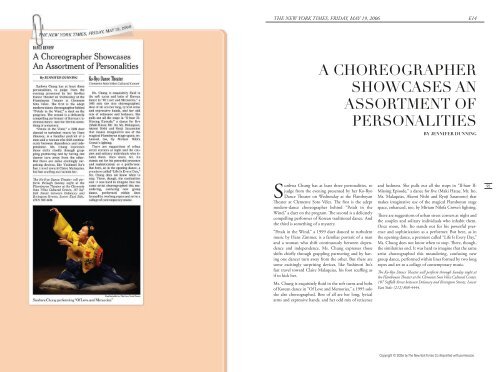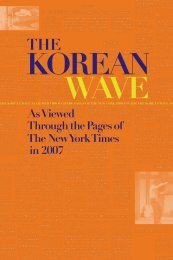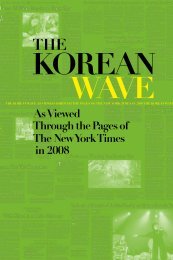The Korean Wave 2006 - Korean Cultural Service
The Korean Wave 2006 - Korean Cultural Service
The Korean Wave 2006 - Korean Cultural Service
Create successful ePaper yourself
Turn your PDF publications into a flip-book with our unique Google optimized e-Paper software.
<strong>The</strong> New York Times, friday, may 19, <strong>2006</strong><br />
E14<br />
A Choreographer<br />
Showcases An<br />
Assortment of<br />
personalities<br />
By JENNIFER DUNNING<br />
Sunhwa Chung has at least three personalities, to<br />
judge from the evening presented by her Ko-Ryo<br />
Dance <strong>The</strong>ater on Wednesday at the Flamboyan<br />
<strong>The</strong>ater at Clemente Soto Vélez. <strong>The</strong> first is the adept<br />
modern-dance choreographer behind “Petals in the<br />
Wind,” a duet on the program. <strong>The</strong> second is a delicately<br />
compelling performer of <strong>Korean</strong> traditional dance. And<br />
the third is something of a mystery.<br />
“Petals in the Wind,” a 1999 duet danced to turbulent<br />
music by Hans Zimmer, is a familiar portrait of a man<br />
and a woman who shift continuously between dependence<br />
and independence. Ms. Chung expresses those<br />
shifts chiefly through grappling partnering and by having<br />
one dancer turn away from the other. But there are<br />
some excitingly surprising devices, like Yoshinori Ito’s<br />
fast travel toward Claire Malaquias, his foot scuffing as<br />
if to kick her.<br />
Ms. Chung is exquisitely fluid in the soft turns and bobs<br />
of <strong>Korean</strong> dance in “Of Love and Memories,” a 1995 solo<br />
she also choreographed. Best of all are her long, lyrical<br />
arms and expressive hands, and her odd mix of reticence<br />
and lushness. She pulls out all the stops in “Il-haw II:<br />
Missing Episode,” a dance for five (Maki Hatae, Mr. Ito,<br />
Ms. Malaquias, Akemi Nishi and Ryoji Sasamoto) that<br />
makes imaginative use of the magical Flamboyan stage<br />
space, enhanced, too, by Miriam Nilofa Crowe’s lighting.<br />
<strong>The</strong>re are suggestions of urban street corners at night and<br />
the couples and solitary individuals who inhabit them.<br />
Once more, Mr. Ito stands out for his powerful presence<br />
and sophistication as a performer. But here, as in<br />
the opening dance, a premiere called “Life Is Every Day,”<br />
Ms. Chung does not know when to stop. <strong>The</strong>re, though,<br />
the similarities end. It was hard to imagine that the same<br />
artist choreographed this meandering, confusing new<br />
group dance, performed within lines formed by two long<br />
ropes and set to a collage of contemporary music.<br />
<strong>The</strong> Ko-Ryo Dance <strong>The</strong>ater will perform through Sunday night at<br />
the Flamboyan <strong>The</strong>ater at the Clemente Soto Vélez <strong>Cultural</strong> Center,<br />
107 Suffolk Street between Delancey and Rivington Streets, Lower<br />
East Side; (212) 868-4444.<br />
95<br />
Copyright © <strong>2006</strong> by <strong>The</strong> New York Times Co. Reprinted with permission.





